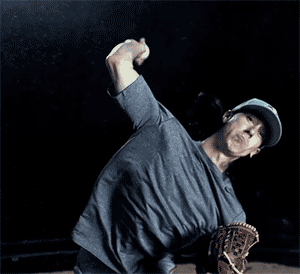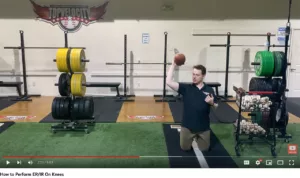 Are you searching for the answer to, What is pronation in baseball? Here is what you need to know!
Are you searching for the answer to, What is pronation in baseball? Here is what you need to know!
Baseball is a strategy-laden sport, with each player weaving a web of ways to improve their skills. Every action, from the power of a batter's swing to the precision of a fielder's throw, is a calculated attempt to stay ahead. Pronation stands out as an unsung star among these strategies. Though it may not get as much attention as a home run or a spectacular catch, it is an important factor that quietly changes the game, especially when it comes to a pitcher's effectiveness.
However, the phrase 'pronation' frequently floats around like an enigmatic phantom, understood by few and underestimated by many. It may appear to be a technical term, but for those on the mound, it can make all the difference. So, to answer the question that has been circling your mind like a curveball, "What is pronation in baseball?" Let's delve into its mechanics, investigate its influence, and discover why it's so important to the art of pitching.
The ABCs of Pronation in Baseball: An Introduction
 Pronation is a term used in the field of biomechanics to describe a certain forearm movement. It is the action of turning the palm from an open to a closed posture or from a facing-up to a facing-down position. In baseball, pronation occurs after the ball is released during pitching. It is critical to the pitch's efficiency and safety, lowering the danger of injury and giving better ball control.
Pronation is a term used in the field of biomechanics to describe a certain forearm movement. It is the action of turning the palm from an open to a closed posture or from a facing-up to a facing-down position. In baseball, pronation occurs after the ball is released during pitching. It is critical to the pitch's efficiency and safety, lowering the danger of injury and giving better ball control.
The Biomechanics Behind Pronation in Baseball
Let's go into the nitty gritty of how this action works. In the grand scheme of a baseball pitch, pronation is an element of the follow-through process. The forearm and wrist naturally roll inward once the ball leaves the hand. This rolling motion, known as pronation, aids in the deceleration of the arm following the intense pitch, acting as a protective mechanism for the elbow.
Muscle Function in Pronation in Baseball
 Several forearm muscles play critical roles in pronation. These include the pronator teres and the pronator quadratus, which collaborate to produce the inward-turning action. The brachioradialis and flexor carpi radialis, in addition to these basic muscles, contribute to the action.
Several forearm muscles play critical roles in pronation. These include the pronator teres and the pronator quadratus, which collaborate to produce the inward-turning action. The brachioradialis and flexor carpi radialis, in addition to these basic muscles, contribute to the action.
The Kinetic Chain: From the Foot to the Fingers
Pronation is a component of a complex kinetic chain, which originates in the legs and ends at the fingertips. This kinetic energy from the earth flows up through the body, producing a pitch. Pronation is the final stage in this kinetic chain, contributing to the pitch's total power and control.
Why is Pronation Important in Baseball?
Now that we've answered the question, "What is pronation in baseball?" let's look at its relevance. In baseball, pronation has a dual purpose: it improves performance while reducing injury.
Improving Pitch Control
Pitchers can alter the trajectory and speed of the ball by pronating. Pitchers can generate a variety of pitches, ranging from fastballs to curveballs, by changing the degree and timing of pronation. Pronation, in essence, gives the delicacy and finesse that distinguishes a good pitcher from a great pitcher.
Lowering the risk of injury
Pronation protects pitchers from injury. It functions as a natural shock absorber, relieving tension on the elbow and shoulder. Pronation can help prevent common baseball injuries including elbow ligament damage and rotator cuff tears by properly decelerating the arm after a pitch.
Pronation in Baseball Improvement: Tips and Techniques
 Recognizing the importance of pronation in baseball, many players work hard to enhance this important part of their pitch. Here are some suggestions and approaches for improving pronation.
Recognizing the importance of pronation in baseball, many players work hard to enhance this important part of their pitch. Here are some suggestions and approaches for improving pronation.
- Conditioning and Strength: Strength training that targets the muscles responsible for pronation can be useful. Wrist curls, reverse curls, and pronator dumbbell rolls are especially effective. Additionally, overall shoulder and forearm training might help to improve pronation.
- Correct Form and Technique: It is not only about strength; good technique is also essential for effective pronation. Work with a coach to perfect your pitching pronation form and timing. Remember that pronation is a natural part of the pitching motion, therefore avoid forcing it, as this could result in damage.
- Utilization of Training Aids: Footballs and Chest Open Throwing drills are two examples of training aids to improve pronation. These can provide tactile feedback and aid in the development of muscle memory for improved pronation.
FAQs (Frequently Asked Questions): Pronation in Baseball
Q1: What is baseball pronation?
A: Pronation is the inward rolling action of the forearm and wrist that occurs following a pitch in baseball. It is important in managing the ball's direction and speed, as well as acting as a protective device for the arm.
Q2: What is the significance of pronation in baseball?
A: Pronation improves pitch control by allowing pitchers to modify the path of the ball. It also serves as a shock absorber, relieving tension on the elbow and shoulder and lessening the chance of injury.
Q3: How can I increase my baseball pronation?
A: Improving pronation entails strength and conditioning exercises targeting essential muscles, working with a coach to learn optimal technique and timing, and using pronation-enhancing training aids.
Q4: Is baseball pronation innate or learned?
A: While pronation is a natural forearm action, incorporating it into the pitching motion efficiently may take practice and technical refining.
Q5: Is excessive pronation hazardous in baseball?
A: Yes, forcing or overpronating can be dangerous and result in injury. It should be a natural component of the pitching process, happening naturally throughout the follow-through.
Q6: Does pronation fluctuate depending on pitch?
A: Yes, depending on the pitch type, the time and degree of pronation can change, contributing to variable speeds and trajectories.
Pronation is more than just a fancy term in baseball; it is a critical component in the art of pitching. Understanding its mechanics, significance, and strategies for improvement can greatly increase a player's performance and longevity in the sport. So, the next time you watch a baseball game or play a round of golf, keep pronation in mind.
TopVelocity will help you take your game to the next level
 If you're looking to improve your baseball game, TopVelocity's Patreon is the place to go. Our experienced pros and devoted trainers are committed to assisting you in mastering the complexities of the sport, with a special emphasis on pronation.
If you're looking to improve your baseball game, TopVelocity's Patreon is the place to go. Our experienced pros and devoted trainers are committed to assisting you in mastering the complexities of the sport, with a special emphasis on pronation.
TopVelocity believes that knowledge, training, and feedback are the three foundations of effective learning. We provide a wide range of content designed to help you better understand pronation and its function in baseball. We offer a series of drills and training routines designed to increase your pronation, making you a more effective and safer pitcher, in addition to informative articles and tips.
But it isn't all. We recognize that constant feedback is essential for improvement, which is why we include a weekly video analysis feature. Our professionals will evaluate your pitching performance, with an emphasis on your pronation technique. These extensive assessments will identify your strengths and weaknesses, allowing you to consistently improve your game.
So, are you ready to embark on the path to becoming a master pitcher? Are you eager to realize the full potential of pronation in your baseball game? If you answered yes, then sign up for the TopVelocity Patreon today! Step aboard the path of continual learning and progress, and allow us to lead you to your baseball goals. TopVelocity allows you to conquer the pitcher's mound. Join us right now!





Trackbacks/Pingbacks